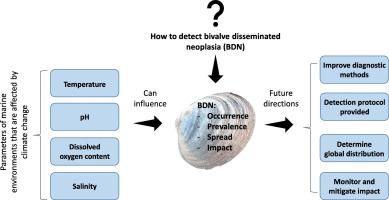Science of the Total Environment ( IF 8.2 ) Pub Date : 2021-02-10 , DOI: 10.1016/j.scitotenv.2021.145134 Georgina Bramwell , Aaron G. Schultz , Craig D.H. Sherman , Mathieu Giraudeau , Frédéric Thomas , Beata Ujvari , Antoine M. Dujon

|
Climate change not only directly impacts marine environments by shifting water temperatures, salinity, pH and dissolved oxygen concentrations, but may also indirectly contribute to the emergence of additional ecosystem stressors, such as infectious diseases, including bivalve disseminated neoplasia. Disseminated neoplasia, a form of cancer found in some bivalves - recently discovered to be transmissible in at least six species - has been shown to impair bivalve health and fitness, with occasional mass outbreaks causing high levels of mortality. As the ability of the host bivalve to respond to disseminated neoplasia, and the survival and transmissibility of disseminated neoplasia both depend on environmental factors, it is crucial to understand the interaction between climate change and disseminated neoplasia epidemiology. Furthermore, with bivalves being species of high ecological and economic importance, there is a rising need for the development of efficient disseminated neoplasia detection tools in order to explore potential effects, mitigate and potentially prevent deleterious disseminated neoplasia outbreaks. Therefore, in this study, we reviewed the current knowledge of climate impacted environmental parameters on disseminated neoplasia and identified good practices and methodology for the detection of transmissible disseminated neoplasia in the wild. By exploring the potential effects changing climate has on disseminated neoplasia dynamics, we identified future research directions in order to advance the field. This included using state of the art disease detection methods and taking in account species’ ecological niches to understand the dynamic of disseminated neoplasia outbreaks in the wild and to investigate whether disseminated neoplasia is present in freshwater ecosystems. Finally, we provided a comprehensive step-by-step guideline for an evidence-based detection of this disease in marine ecosystems.
中文翻译:

审查气候变化对弥漫性瘤形成的潜在影响,重点是在海洋双壳类种群中进行有效检测
气候变化不仅会通过改变水温,盐度,pH和溶解氧浓度直接影响海洋环境,而且还可能间接导致其他生态系统压力源的出现,例如传染性疾病,包括双壳类扩散性肿瘤。弥漫性瘤形成是一种在某些双壳类动物中发现的癌症形式-最近发现可在至少六个物种中传播-已显示会损害双壳类动物的健康和适应能力,偶发的大规模爆发会导致高死亡率。由于宿主双壳类动物对弥漫性瘤形成的反应能力以及弥漫性瘤的存活和传播都取决于环境因素,因此了解气候变化与弥漫性瘤的流行病学之间的相互作用至关重要。此外,由于双壳类动物具有高度的生态和经济重要性,因此,为了开发潜在的影响,减轻和潜在地防止有害的弥漫性瘤变爆发,人们日益需要开发高效的弥漫性瘤变检测工具。因此,在这项研究中,我们回顾了有关气候影响的环境参数对弥漫性瘤形成的当前知识,并确定了在野外检测可传播的弥漫性瘤形成的良好实践和方法。通过探索气候变化对扩散性肿瘤形成动力学的潜在影响,我们确定了未来的研究方向,以推动该领域的发展。这包括使用最先进的疾病检测方法,并考虑物种的生态位,以了解野生环境中已扩散的赘生物爆发的动态,并调查淡水生态系统中是否存在已扩散的赘生物。最后,我们提供了全面的循序渐进指南,用于在海洋生态系统中基于证据的对该疾病的检测。

































 京公网安备 11010802027423号
京公网安备 11010802027423号